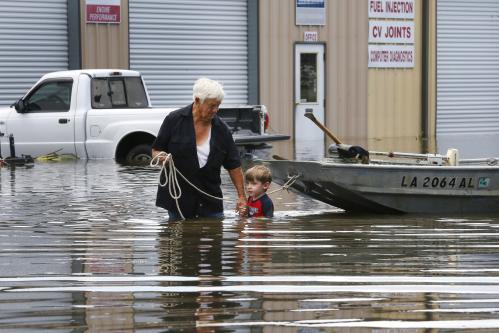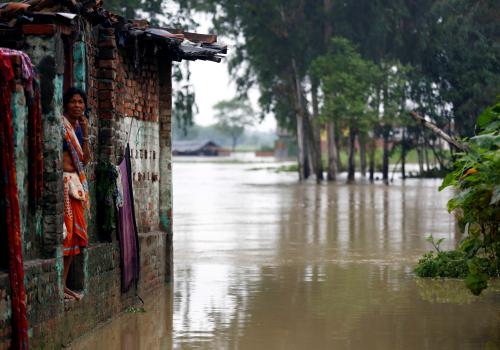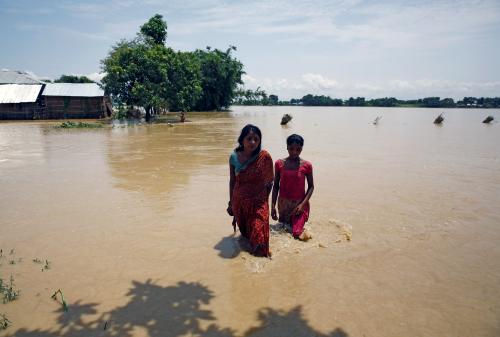Highly destructive floods, storms, heatwaves, and droughts have become the new climate norm. The massive rainfall that has wreaked havoc in Sri Lanka and India’s record-breaking heatwave melting urban tarmac are just two of the latest examples of the spike in climate-related natural hazards. It is in this context of rising danger that the Trump administration’s decision to ditch the Paris Agreement on climate changes proves irresponsible.
To be sure, local conditions are aggravating factors—deforestation, land degradation, population pressures, and deficits in disaster management—and they need careful attention. But make no mistake, global warming is exacerbating changes in temperatures and precipitation, making countries more disaster-prone than ever.
Rising climate-related disasters is a global phenomenon (Figure 1). Earlier this year in Colombia, heavy rains overnight caused rivers to burst their banks, taking over 200 lives. In Quebec, Canada, excessive rainfall flooded thousands of homes. But poorer countries, especially in Asia, are bearing the largest brunt. In Sri Lanka’s latest floods, the worst since 2003, some places experienced more rain in a day than the usual for a year. Landslides are becoming common in many parts of Asia during the monsoon season because uplands have been stripped of forest cover to clear land for export crops.
Figure 1: Increasing frequency of floods and storms, 1960-2015
Locally, disaster risks are increasing because more people are exposed. Higher population densities across developing Asia mean that more people are moving into flood-prone areas. Unregulated urbanization and poor drainage and flood protection are dangerously raising the stakes. The effect of the severe monsoon floods of 2015 in Chennai, India, were made worse by uncontrolled construction over natural flood discharge channels.
Wrong decisions in disaster flood management can be disastrous. Thailand’s 2011 floods—which submerged economic heartlands and caused losses amounting to 13 percent of GDP—were aggravated by the misjudged release of water from dams. During the 2013 floods in Uttarakhand, India, the debris from dam construction upstream blocked rivers, augmenting the overflow.
While scientists are careful not to link any single flood or storm to climate change, the connection of these events to global warming is unmistakable (Figure 2). Global data over the past 50 years show that the incidence of floods and storms is linked to not only population density and people’s vulnerability to hazards but also to greenhouse gas emissions.
Figure 2: Carbon dioxide atmospheric concentrations at Mauna Loa and global annual temperature anomaly: 1959–2014

So, disaster prevention must become a bigger priority to protect human and physical capital and probably needs to be 1–2 percent of national budgets. A stark example of this under-resourced investment is that for every $100 of official development assistance, only $0.40 go to disaster risk reduction. Yet acting on disaster prevention makes good economic sense. New York’s disaster preparedness and prevention efforts after Hurricane Sandy in 2012 boosted confidence among investors and businesses, leveraged private investments, and helped stimulate growth.
A neglected aspect is making hospitals, emergency shelters, and other vital installations more disaster resistant and ensuring functioning lifelines—notably potable water, first aid, and power supplies—during disasters. Readiness also involves care in zoning regulations and building codes to protect businesses, homes, and neighborhoods. This is essential as floods can disrupt supply chains and information networks, as we have seen in Sri Lanka, Chennai, and Thailand.
But local action will be futile without global action, and the 2015 Paris Agreement among 195 nations is critical. Vast differences exist in emissions from countries. China is the largest emitter in the aggregate, while the United States is way ahead in per capita terms. Many will need technological and financial support in adapting to climate change. To this end, a $100-billion financing plan to support climate adaptation and mitigation is a key component of the Paris Agreement.
The Trump administration’s decision to pull out of the agreement flies in the face of all this reality. (The only other two non-participants are Syria, who is in a civil war, and Nicaragua, who actually wanted a stronger agreement). The decision is against the U.S.’s own economic and geopolitical interests. It also shirks responsibility for the country’s share of the carbon footprint driving everyone’s fortunes.
Sri Lanka’s floods and India’s heatwaves are stark reminders of the needed priority for disaster resilience in national programs. But for these programs to have any chance of success, climate mitigation, especially by the biggest emitters, must take center stage.








Commentary
The climate crisis
June 5, 2017